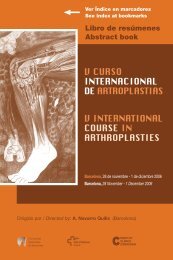Notas / Notes - Active Congress.......
Notas / Notes - Active Congress.......
Notas / Notes - Active Congress.......
You also want an ePaper? Increase the reach of your titles
YUMPU automatically turns print PDFs into web optimized ePapers that Google loves.
MIÉRCOLES / WEDNESDAY<br />
80<br />
DIAGNOSIS OF THE PAINFUL<br />
CEMENTLESS HIP<br />
Rudolph Geesink MD PhD<br />
Professor of Orthopaedic Surgery, Maastricht University,<br />
Netherlands<br />
If the goals of arthroplasty to restore longevity of pain-free<br />
function are not met, the patient may visit the surgeon for<br />
further diagnosis and selection of treatment. Many factors<br />
may be responsible for problems in arthroplasty and radiology<br />
is an important diagnostic instrument. However with cementless<br />
arthroplasty radiological failure criteria are much more<br />
difficult to define compared to cemented arthroplasty. This<br />
is mainly caused by the great variety in fixation principles<br />
and design factors of cementless hip implants.<br />
- material (stiffness, titanium or CoChr alloys)<br />
- design (cylindrical 2-D 3-D wedge)<br />
- surface texture (macro-texture, porous-or fiber-mesh<br />
coating)<br />
- biological coating (HA-coating of variable length)<br />
In addition there are multiple failure mechanisms for implants:<br />
- fracture, device or bone<br />
- disturbed biomechanics<br />
- loosening<br />
- infection<br />
- wear & lysis<br />
- stress-shielding<br />
- pain without any of previous problems<br />
Radiological diagnostic tools may include:<br />
- standard X-rays, protocol & lateral for position and gross<br />
fixation<br />
- interface study using contrast or nuclear arthrography<br />
- technetium, gallium or indium scintigraphy to rule out<br />
in-fection<br />
- CT-scan to detect hidden osteolysis (modern metal removal<br />
software)<br />
- fluoroscopy rarely necessary<br />
Through systematic use of radiological tools, proper interpretation<br />
of clinical signs plus knowledge of potential failure mechanisms<br />
it is usually possible to arrive at a diagnosis and<br />
prove or disprove one of the previous failure mechanisms.<br />
Points to remember:<br />
- interpret clinical signs<br />
- know the implant characteristics<br />
- be aware of potential problems<br />
- choose correct diagnostic tools<br />
- interpret radiographic signs<br />
- check for infection<br />
- diagnosis usually possible preoperatively<br />
THE INCIDENCE OF THIGH PAIN AND<br />
CLINICAL OUTCOME OF A TAPERED<br />
FEMORAL STEM<br />
Victor M. Goldberg, M.D; Sam Akhavan, M.D.<br />
Case Medical Center, Department of Orthopaedics<br />
Cleveland, Ohio (USA)<br />
Tapered femoral components were designed to provide a<br />
cementless alternative in patients with narrow femoral canals.<br />
Major concerns with this stem include perioperative fracture<br />
and thigh pain. To ascertain the frequency of these concerns,<br />
we retrospectively reviewed 100 consecutive hips in 97 patients<br />
with osteoarthritis who underwent total hip arthroplasty with<br />
a tapered fibermetal femoral component. Patients were evaluated<br />
postoperatively using Harris Hip Scores and sequential<br />
radiographs. The average age of the patients was 56.5 years<br />
(range 33.7-73.5 yrs). Minimum followup was 6 years (average<br />
6-10 yrs). One patient died at 1.3 years and was excluded<br />
from the study. Four patients had incomplete perioperative<br />
fractures of the calcar without extension below the lesser trochanter.<br />
All fractures were recognized perioperatively and<br />
fixed with cerclage wires without further problems. Four patient<br />
underwent revision surgery, two for recurrent dislocation secondary<br />
to malpositioning of the acetabular cup, one for a<br />
greater trochanteric fracture after a fall, and one for a fractured<br />
zirconium femoral head. At last followup, the mean Harris Hip<br />
Score was 98 (Range 86-100); two patients had mild anterior<br />
thigh pain. All femoral stems appeared to have bony integration<br />
radiographically. Tapered femoral stems provide a cementless<br />
alternative in patients with a narrow femoral canal without<br />
undue risk of perioperative fracture of thigh pain.<br />
LEG LENGTH INEQUALITY:<br />
PREVENTION AND MANAGEMENT<br />
Douglas A. Dennis, MD<br />
Adjunct Professor, Department of Biomedical Engineering<br />
University of Tennessee, Assistant Clinical Professor,<br />
University of Colorado Health Sciences Center, Clinical<br />
Director, Rocky Mountain Musculoskeletal Research<br />
Laboratory<br />
Denver, Colorado (USA)<br />
Leg length discrepancy (LLD) is an undesired complication<br />
of total hip arthroplasty (THA). It creates numerous potential<br />
adverse effects including low back pain, sciatica, limp, hip<br />
instability, increased hip forces, hip pain (in non-implanted





